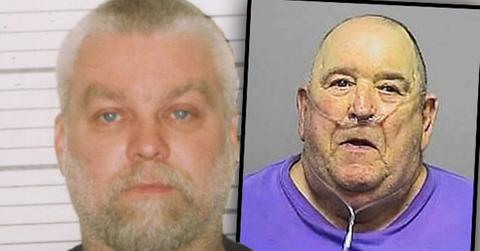'Steven Avery Is Completely Innocent': Top Cop Claims THIS Serial Killer Framed 'Making A Murderer' Subject — Read His Stunning Proof

Feb. 3 2016, Updated 9:02 p.m. ET
One of America's most notorious psycho killers is the man behind the murder that mistakenly put Steven Avery behind bars for life — and both the cops and a sensational new documentary series got it wrong, retired police sergeant John Cameron exclusively told RadarOnline.com.
A special RadarOnline.com investigation uncovered the ex-FBI cold-case expert, who shared a shocking stash of evidence that shows Avery and his nephew, Brendan Dassey, were pawns in the diabolical scheme of the real murderer ― infamous serial killer Edward Wayne Edwards.
While inmate Avery cries out for a new trial, more than 400,000 outraged viewers of the controversial documentary series Making a Murderer have signed a petition demanding his immediate release.
"Steven Avery is completely innocent," said Cameron, who played a pivotal role in the capture of child cannibal killer Nathan Bar-Jonah. "He was set up by Edwards!"
Among the compelling evidence: Avery and Dassey were convicted of shooting, mutilating and burning the corpse of 25-year-old photographer Teresa Halbach in 2005, a year in which Edwards lived just an hour away from the brutal murder scene and a crime which uniquely mirrors one of Edwards' killings.
Edwards, who was convicted of five murders and was sentenced to death in March 2011, died of natural causes on death row in Columbus, Ohio, just weeks later. However, he is suspected of many more vicious slayings and slyly hinted his list of victims is far longer than cops ever proved.
Cameron is convinced that Edwards targeted the junk man and his nephew as the fall guys for Halbach's murder following Avery's release from prison on a trumped-up rape conviction.
The detective believes Edwards was lurking, laying in wait outside Avery's junkyard when he lured Halbach to a secluded corner before shooting her and dropping the corpse into her car.
"He had done exactly the same thing in California in 1955 when he kidnapped and murdered a doctor's 14-year-old daughter called Stephanie Bryan," Cameron shockingly told RadarOnline.com. "He hid her body for three months and then planted the girl's property in a man named Burton Abbott's basement and in his garage," he explained. "Abbott was convicted on circumstantial evidence but always protested that he was framed. He was executed at San Quentin minutes before a stay of execution was delivered."
Cameron linked Edwards to Bryan through cryptic comments the serial killer made in an unpublished autobiography in which he described the numerous murders he was not convicted of. He simply changed the names of the victims to avoid being investigated.
When Cameron interviewed Edwards' ex-wife Jeanette White in 2011, he discovered that she was with her husband in San Francisco in 1956, just miles from where Stephanie was murdered. Cameron also said she told him that Edwards had sent an anonymous note to the judge presiding over Abbott's trial to persuade him of his guilt.
"When I first started watching Making a Murderer, I couldn't believe what I was seeing … it's the same kind of setup," Cameron explained.
"Only this time, he not only set up Avery, he also got the cops who wanted him to be guilty."
The 10-part series suggests authorities framed Avery in retaliation for a $36 million lawsuit he had filed against Manitowoc County, Wis., for the wrongful rape conviction.
Cameron also pointed out that Edwards was familiar with the area where Halbach was murdered.
He had coldly killed Tim Hack and Kelly Drew after they attended a wedding reception in Sullivan, Wis., not far from Two Rivers in 1980. He also lived just an hour away from Avery's salvage yard in 2005, the same year Halbach was slain.
In another chilling coincidence, Cameron said a shadowy figure ominously appears behind Wisconsin prosecutor Ken Kratz in the sixth episode of the series.
"It looks like Edwards to me," said Cameron, who added that the serial killer was known to show up at court hearings and funerals during high-profile murder cases. "He got off on that," he added.
He's also convinced that Edwards was involved in the notorious "West Memphis Three" case, in which three teenagers were convicted of killing three young boys during a satanic ritual in Arkansas in 1993 ― and that he briefly appeared in the HBO documentary Paradise Lost that chronicled the brutal killings.
The suspects won their freedom in 2011.
Now, Cameron reveals that he can produce one more smoking gun that could blow Avery's conviction out of the water.
The detective reported that a new anonymous note ― not too different from the one he sent to the judge presiding over the Abbott trial ― was sent to Wisconsin investigators in the Avery case.
"It contained information only the killer could know," said Cameron.

"The letter is referred to as 'cryptic' by the judge, and contained specific details of how Teresa was killed and burned in a smelter. This letter was handwritten in the same way, and I believe it came from Edwards."
But in the rush to convict Avery, the letter was disregarded, said Cameron.
"It needs to be thoroughly examined," he said. "These cryptic letters are Edwards' signature. He's set up Avery, just the way he did with Abbott."
The retired detective has aggressively reached out to prosecutor Kratz and Manitowoc County investigators to mention the dead serial killer's numerous connections to the case.
"He may be dead, but I don't want him to get away with another murder," he said.


